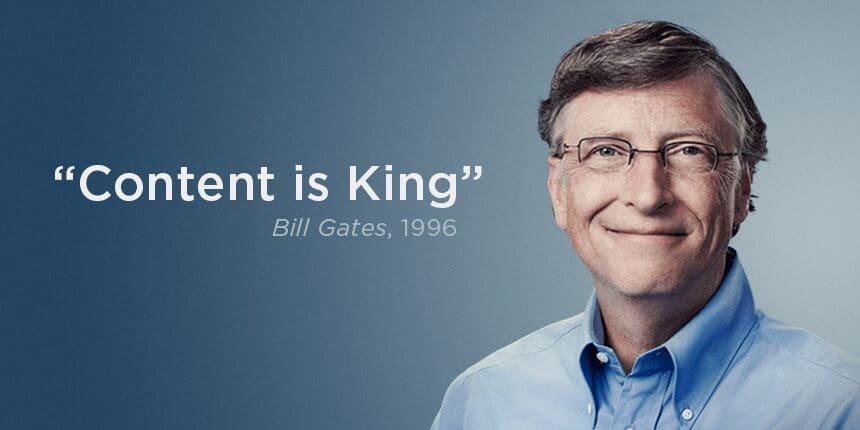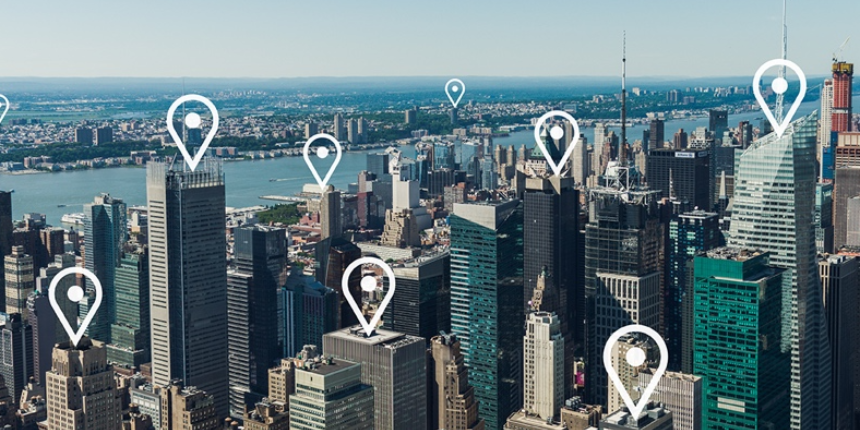

Twenty years or one score ago — during the dawn of email, Yahoo’s first IPO offering and Sandra Bullock’s magnum opus The Net — Bill Gates penned the 1996 essay “Content is King”. An ambitious forecast on the future of the internet, both Yahoo and even Microsoft have failed to capitalize on the Gates prophecy, but that’s not to say the “Content is King” mantra isn’t alive and well. In fact, his words may be more relevant now than ever…
1. Television as a footprint
“Content is where I expect much of the real money will be made on the Internet, just as it was in broadcasting,” opens Gates’ essay as he compares the early days of the internet to that of the 1950s era of broadcast TV. It was during this time that TV became a cornerstone of advertising plans— as well as a Mad Men subplot — boosting commercial spending to historical highs as the reach provided by that glowing box exceeded any other medium. And consumer consumption was more than willing to keep up with the hard sell, growing household spending more than tenfold from $12.3 million in 1949 to $128 million in 1951.
The historical TV numbers sound eerily familiar as today advertisers ramp up their paid media efforts to jockey for position among competitors. By 2019 it’s estimated that digital will account for 38 percent of global ad outlays, a proportion as large as TV, which has still clung to the biggest share of spending for more than a decade. “But what about that ROI?” you’ll cry. In 2014, US consumers spent $278 billion online and that number just keeps on growing.
2. The definition of content is wide
“When it comes to an interactive network such as the Internet, the definition of ‘content’ becomes very wide,” says Bill Gates, and he’s not wrong. Web content encompasses anything that is textual, visual or even aural in nature. That Snapchat you flipped to your friend? It’s content. The Instagram of your perfectly arranged latte, croissant and morning read… #BreakfastClub? It’s content. The autoplay ad that forces extra loud audio through your browser? That’s unfortunately content too.
Social media has helped blend the boundaries between traditional text and multimedia content, making the role of a marketing strategist all the more important in being able to wrangle each of these delivery systems, at the most appropriate time. It’s up to brands to follow the audience and engage through the method they choose rather than attempt to fit their latest campaign into a square hole.
3. No company is too small
“But the broad opportunities for most companies involve supplying information or entertainment. No company is too small to participate,” says Bill (I feel we’re on a first name basis by now). The caveat to this statement is a particularly interesting one in light of recent developments in social media.
“Over 1 million SMBs [small-to-medium businesses] have posted videos and done really small ad buys around them,” Facebook COO Sheryl Sandberg recently said in the company’s Q1 earnings call. “And that’s pretty cool because I don’t think there are probably One million advertisers who have bought TV ads in that same period of time.” Case in point? Content marketing in the social sphere has levelled the playing field between brands. Sure we can argue that organic referral is increasingly being curtailed at the expense of paid media (here’s looking at you Facebook), but still the cost of such placement is significantly lower than traditional TV/radio/print advertising.
4. Print will diversify or die
“To be successful online, a magazine can’t just take what it has in print and move it to the electronic realm. There isn’t enough depth or interactivity in print content to overcome the drawbacks of the online medium,” says Bill. In the past decade, no other industry has struggled as much as print in adapting to the online revolution. Newspapers and magazines have suffered dwindling subscription numbers, as well as a loss in ad revenue, as readers turn to the internet for free news 24/7. Even media pay walls have failed to stem the loss, while new media companies like Gawker and Buzzfeed prosper under the digital reign.
5. Give them something of value
“If people are to be expected to put up with turning on a computer to read a screen, they must be rewarded with deep and extremely up-to-date information that they can explore at will.” I’m sure when Bill Gates first made this claim, he had no idea of the future dominance of tablets and smartphones allowing for constant connectivity anywhere. It’s less of a chore to “turn on a computer and read a screen,” but still the sentiment remains that people’s valuable time should only be taken up with in-depth, quality content. This is the basis for all content marketing, but often in the squeeze of 140 characters, instantaneous reaction and ever-increasing post frequency, it’s easy to forget.
6. International reach on a local scale
“Although the gold rush atmosphere today is primarily confined to the United States, I expect it to sweep the world as communications costs come down and a critical mass of localised content becomes available in different countries.”
Almost two decades after Bill Gates predicted the rise in global connectivity, more than 40 percent of the world’s population can access the internet. Of course, this also highlights the unconnected 60 percent, but increasingly this number is shrinking thanks to philanthropic initiatives. Critical mass will one day be achieved, leading to increased demand for localised geo-targeted content adapted to suit language, currency and culture.
Stay Forward
Get exclusive insights into digital
media's top-trending topics delivered
directly to your inbox.
7. The ROI struggle
“For the Internet to thrive, content providers must be paid for their work. The long-term prospects are good, but I expect a lot of disappointment in the short-term as content companies struggle to make money through advertising or subscriptions.”
While some digital marketing tactics have the ability to yield instant results, content marketing is not always able to deliver a quick ROI (that’s if an agency is even tracking the effect at all). In fact, it can sometimes takes weeks, months or even a year for lead generation uplift thanks to the compound interest effect of accumulated content. In that way an effective content marketing strategy can be likened to a financial portfolio with a year-on-year return through a balanced mix of products. Hey, I bet you never thought of a blog post as stock before!
The point is, with such long-term returns it can be difficult for marketers to measure the real ROI as, so often, content acts as a first touchpoint in the consumer journey. Increasingly we are seeing more opportunities for conversions directly within social platforms, but as Bill surmises, the short-term gains are still minimal.
8. Attract attention
“In the long run, advertising is promising. An advantage of interactive advertising is that an initial message needs only to attract attention rather than convey much information.”
With so many brands on social media vying for attention, more importance should be placed on attracting a quality audience rather than preaching to the masses with an incessant stream of brand hoorah. High-value and relevant content will always have its place in appealing to the ideal persona, while problems can occur with brands that are focused solely on boosting their social numbers; gleaning as many likes, retweets and shares as is digitally possible. These brands will essentially be left shouting into an empty void as their information overload is left hanging like an awkward silence at a party.
9. Ads: I hate you
“Some reluctance on the part of advertisers may be justified because many Internet users are less-than-thrilled about seeing advertising.”
Believe it or not, but people don’t want to shop where they socialise. No really, in between posts from your sister about her new kitchen renovation – “So in love with this tiled finish!” – people couldn’t care less about the [insert brand name] ad for an extendable duster. Unless they happen to be thinking their ceiling fan is looking kinda furry and need a new duster at that very moment. It’s part of the reason why banner advertising has seen such a stark decline in effectivenessas users are a lot savvier than marketers sometimes give credit. That come-hither “I dare you to click me” plea is about as enticing as a “Do you come here often” pickup line and reeks of just as much desperation.
In light of the ad banner’s demise, native advertising has seen a surge in popularity among publishers. Far from a perfect model in itself – just ask John Oliver for his take – native advertising is the next best thing for brand awareness when, as Bill puts it, “users are less-than-thrilled about seeing advertising.” The lines between news and ads may be blurring on some sites, but your morning digest has to get funded somehow.
10. A marketplace of ideas
“Those who succeed will propel the Internet forward as a marketplace of ideas, experiences, and products-a marketplace of content.”
Finally, we are left with Bill Gate’s parting thoughts in that those who succeed in crafting high-value content will make the internet a better place. Excuse me for getting all Louis Armstrong on you, but it has to be said that this “wonderful world” can be balanced with a little give-and-take between both parties. Users can accept that digital marketing is a necessary evil for publishers to monetise, companies to profit and the economy to keep trundling along, while marketers can agree to more transparency and less spammy practices. We’re linked by the same networks so can’t we all just get along?
Emma Jones, Content and Social Strategist
Contact DAC today to find out more!
Contributing Experts
Stay Forward
Get exclusive insights into digital
media's top-trending topics delivered
directly to your inbox.


